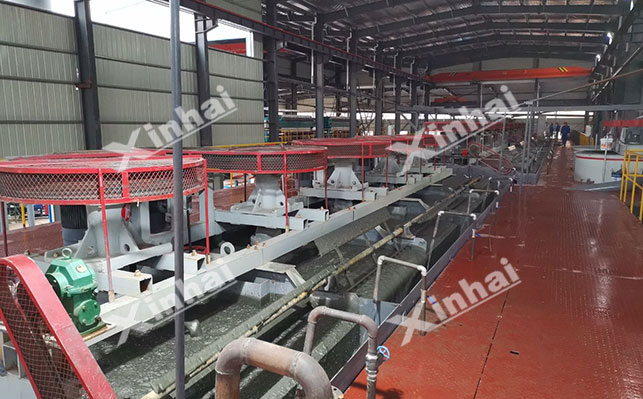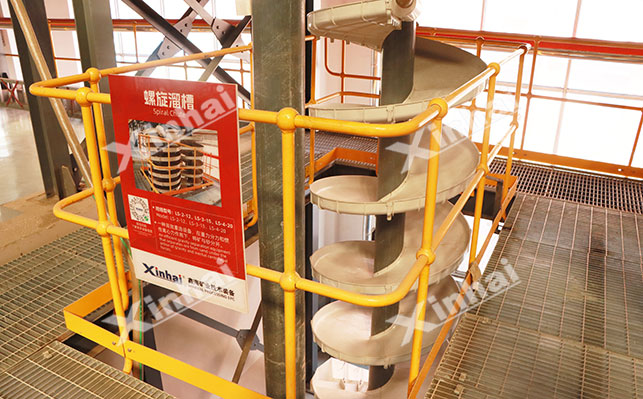
15311826613
Click to add WeChatWith gold prices running high, previously difficult-to-develop low-grade gold mines have become new wealth opportunities. For investors, the key to success lies in accurately selecting gold ore beneficiation technology, which directly determines your resource monetization efficiency and return on investment. Let us help you master core beneficiation solutions, make precise plans, and directly transform market opportunities into tangible profits.
In quartz vein type gold ore, gold often exists in coarse-grained (mostly >74μm) monomeric form, coexisting with quartz, without complex associated minerals. Gold beneficiation is relatively easy, making it a preferred resource for investors seeking quick capital recovery. For this type of gold ore beneficiation, a combined gravity separation-flotation-cyanidation process is commonly used, consisting of four steps:

Crushing and Grinding: A three-stage closed-circuit crushing process combined with ball mill grinding is typically employed. The ore particle size is first ground to at least 85% -0.074mm to ensure a gold liberation degree of ≥90%, laying the foundation for subsequent gold beneficiation.
Gravity Concentration: Primarily used to recover coarse gold particles. A shaking table (or centrifugal separator) is connected to the grinding circuit. Utilizing the density difference between gold and gangue, coarse gold particles are recovered in advance, achieving a recovery rate of 70%-80%. The coarse gold can be directly smelted into refined gold for sale, achieving capital recovery in approximately 15 days, alleviating the initial cash flow pressure for investors.
Flotation enrichment: Used for enriching fine-grained gold, the tailings after gravity separation are subjected to a flotation system with the addition of butyl xanthate and No. 2 oil. Flotation is carried out under conditions of pH 8-9, enriching fine-grained gold into the flotation concentrate. The flotation recovery rate reaches 85%-90%.
Cyanide leaching: The flotation concentrate is fed into a carbon leaching tank, where sodium cyanide and activated carbon are added. Gold forms a gold-cyanide complex with cyanide and is adsorbed by the activated carbon. Then, pure gold is obtained through desorption and electrolysis, with a leaching recovery rate of over 95%.
In beneficiation of gold deposits associated with sulfide ores, gold is encapsulated in the form of fine particles (<37μm) within sulfide minerals such as pyrite and arsenopyrite. Valuable elements such as silver, copper, and sulfur are often associated. Gold beneficiation requires first enriching the sulfide minerals, then releasing the encapsulated gold. Simultaneously, the profitability can be increased by comprehensively recovering associated elements. This type of gold deposit typically employs a flotation + concentrate pretreatment process, which consists of three steps:

Fine grinding and liberation of sulfide ore: A combination of rod mill and ball mill is used for fine grinding to reduce the ore particle size to over 90% -0.074mm, ensuring a liberation degree of ≥85% for the sulfide minerals. Insufficient liberation will prevent the gold trapped within the sulfide ore from being recovered in subsequent processes, resulting in a 10%-15% loss in recovery rate.
Flotation enrichment: Amyl xanthate and pine oil are added, and flotation is performed at a pH of 9-10 to enrich the gold-bearing sulfide ore into a flotation concentrate. The flotation recovery rate can reach 85%-90%.
Gold Extraction from Concentrate Pretreatment: Low-sulfur concentrates can be sold directly to smelters for gold extraction via pyrometallurgical processes. This saves investors on pretreatment equipment investment and is suitable for small to medium-sized projects. High-sulfur concentrates (sulfur content ≥15%) can be pretreated using roasting-cyanidation or pressurized oxidation-cyanidation methods to oxidize sulfide minerals, release encapsulated gold, and then undergo cyanidation leaching, achieving a total recovery rate of 88%-92%.
Refractory gold ores often include carbonaceous gold ores, encapsulated gold ores, and arsenic-bearing gold ores. Traditional gold beneficiation processes have a recovery rate of <40%, requiring technological breakthroughs to achieve profitability. This approach is suitable for investors with technological reserves. For this type of gold ore, a pretreatment-cyanidation process is commonly used. The key lies in the pretreatment process to remove interference. The main methods fall into four categories:

Roasting Oxidation Pretreatment: Suitable for carbonaceous and arsenic-containing gold ores. The ore is roasted at 700-800℃ to remove organic carbon and arsenic, followed by cyanidation leaching. The total recovery rate can reach 80%-85%. This method is mature and low-cost, but it produces pollutants such as sulfur dioxide and arsenic oxides, requiring supporting environmental protection equipment. It is suitable for projects in areas with relaxed environmental policies.
Pressure Oxidation Pretreatment: This uses a wet process. In a high-pressure reactor at 200-220℃ and 4-6 MPa, oxygen is used to oxidize carbon, arsenic, and sulfides in the ore, breaking down encapsulation and eliminating gold-robbing effects, followed by cyanidation leaching. The total recovery rate can reach 90%-93%. It has good environmental performance and high recovery rates, but requires large equipment investment and has high operating costs. It is suitable for high-grade, large-scale, and difficult-to-process gold ore projects.
Bacterial oxidation pretreatment: This method utilizes microorganisms such as Thiobacillus ferrooxidans and Thiobacillus thiooxidans* to decompose sulfides and remove gold inclusions under normal temperature and pressure, followed by cyanide leaching. The total recovery rate can reach 85%-90%. This method is low-cost and environmentally friendly, but has a long oxidation cycle and is temperature-sensitive. It is suitable for warm southern regions and small to medium-sized difficult-to-process gold mine projects.
Ultrafine grinding pretreatment: This method uses an ultrafine ball mill to grind the ore to over 90% -20μm. Mechanical force is used to remove the gold inclusions from quartz or sulfides, followed by cyanide-free leaching. The total recovery rate can reach 85%-90%. This process is simple and chemical-free, but energy-intensive. It is suitable for difficult-to-process gold mines with thin gold inclusions and high grades.
Placer gold mostly exists as native gold in gravel, without inclusions or complex associated minerals. Gold beneficiation only requires physical separation methods, making it a primary ore type for investors seeking low-cost trial and error. The process primarily utilizes gravity separation, and the flow consists of three steps:

Washing and Screening: The ore is washed using a cylindrical washing machine to remove mud and impurities. Then, a vibrating screen classifies the ore into coarse (20-50mm), medium (5-20mm), and fine (<5mm) particles to prevent mixing of different particle sizes and ensure efficient subsequent gravity separation.
Roughening and Enrichment: Gravity separation equipment is selected based on particle size. A jig is used for coarse particles, a spiral sluice for medium particles, and a centrifugal separator for fine particles. Gravity separation removes over 95% of the waste rock, yielding a roughing concentrate with a grade of 10-20 g/t.
Refinement and Purification: The roughing concentrate is fed into a shaking table or belt conveyor sluice for further separation of gold and gangue, yielding a placer gold concentrate with a grade >100 g/t. Finally, pure gold is obtained through pyrometallurgical smelting, with a total recovery rate of 90%-95%.
The above describes different gold ore beneficiation methods. During periods of high gold prices, the choice and implementation of gold beneficiation processes directly impact investment returns. The key to converting resource value into actual profits lies in the technological adaptability, cost controllability, and environmental compliance of the gold beneficiation process. For investors, it is crucial to remember these four points:
Conduct trials before determining the process: Clearly define ore characteristics through professional beneficiation trials to avoid selecting processes based on experience, which could lead to substandard recovery rates.
Design beneficiation processes specifically based on trials: Design processes based on trial data, controlling every aspect throughout to avoid wasteful generic designs.
Adapt equipment for cost reduction and efficiency improvement: Select suitable equipment based on the process and ore properties, avoiding blindly pursuing high-end options and prioritizing cost-effectiveness.
Ensure environmental compliance and long-term profitability: Include environmental protection investments in the project budget, avoiding penalties through compliant operation and achieving long-term stable returns.
Xinhai provides integrated services encompassing "beneficiation trials - process design - equipment manufacturing - installation and commissioning - operational guidance," having already helped over 120 gold mine projects both domestically and internationally achieve efficient gold beneficiation. The average project recovery rate is 5%-8% higher than the industry average, and the investment payback period is shortened by 0.8-1.2 years. During periods of high gold prices and potential profits, choosing a professional partner can help investors effectively mitigate risks, seize opportunities, and make gold selection an engine for profit growth.